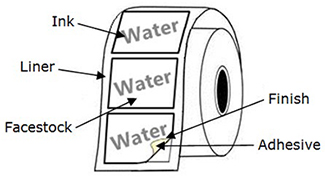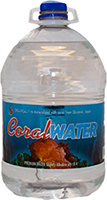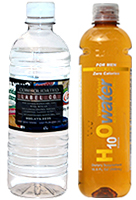Water bottle labels face several hurdles when it comes to maintaining their quality. Condensation, friction, product handling, and adhesion – all these factors should be considered when selecting label materials to better ensure your professionally printed labels look good and don’t easily deteriorate. Below are some options and considerations to keep in mind when ordering pre-printed waterproof labels.
How Water Bottle Labels Work
Before we jump into various label options, let’s discuss the basic construction of custom roll labels (our most popular format) so it will be easier for you to understand and select label materials. Custom labels typically comprise of five layers of material: release liner, adhesive, face stock, ink and finish.
Now that you have a clearer picture of pre-printed roll labels, let’s see which materials – in particular, face stocks and finishes – are most likely to work for your project.
It’s All in the Label Material
When selecting label materials, there are several things you should keep in mind like label design, budget, application method, etc. Below are some material options to consider so you can get a better idea of what to do with your water bottle labels.
White Glossy Labels
- Popular in the food and beverage markets, glossy water bottle labels can be printed on white film or semi-gloss paper. Both options work well for water bottle labels, however, semi-gloss paper tends to be more popular since it’s a cost-effective material that has comparable print quality and lustre.
- A laminate is recommended for white glossy labels to protect the ink from running, and to maintain the material’s integrity in case of friction and product handling. White glossy labels are a good option if you need to label a lot of water bottles or require large labels like for jugs.
Clear Transparent Labels
- Clear water bottle labels are a nice fit for many customers since the film material is durable and goes well with clear bottles. Clear labels can achieve a “no label” look that tends to look more high-end than other types of labels. They can also be used to create a 3D effect when front and back labels are used.
- In comparison to paper-based labels, clear water bottle labels are harder to tear or rip; however, the cost per label tends to be more. Also, keep in mind that applying clear water bottle labels by hand can cause bubbling to occur – a machine label applicator is the most effective way to avoid this issue for a successful application.
Shiny Foil Labels
- To make your water bottle labels stand out, consider using metallic touches. You can have your labels printed on metalized silver paper or foil film, as well as print foil material on other types of labels, to suit your budget and how much metallic you want. Shiny labels are an effective way to grab people’s attention while making a brand more memorable.
- A UV coating or clear laminate can be applied to metalized silver paper to add shine and protect the ink from running. Laminate is better for waterproofing; however, prolonged exposure to condensation/moisture can end up seeping through the material layers and cause label damage. If long-term quality is a must, film-based labels would be best.
Asset Print has printed water bottle labels for businesses, non-profits, schools, individuals and more so they understand the importance of selecting the right materials. As a label buyer, it would be helpful for you to know your project’s needs before making a final selection – that means having a clear labeling strategy in place (don’t worry, it doesn’t have to be as formal as it sounds). Having a plan will make it easier to select the right materials and printing techniques to achieve your vision.
Article source: https://consolidatedlabel.com/label-articles/materials-successful-water-bottle-labels/




No comments:
Post a Comment